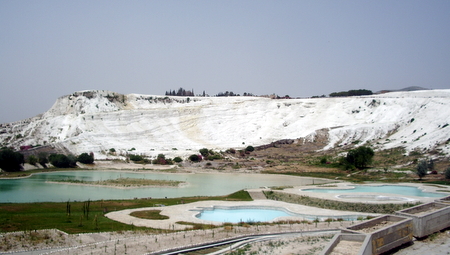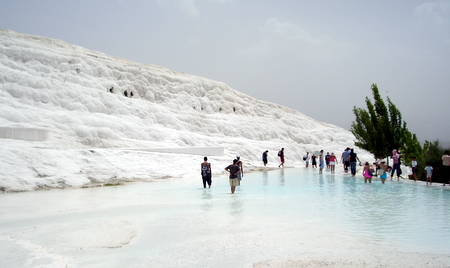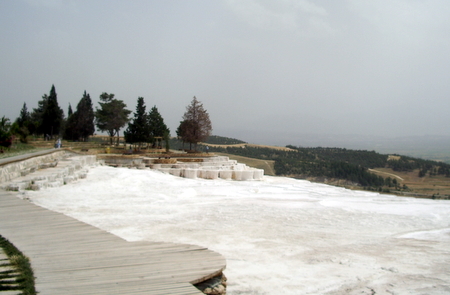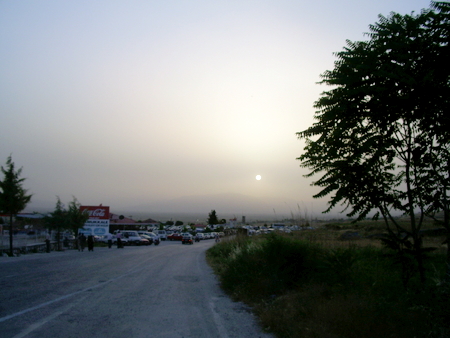I stand at the foot of the great travertine terrace pools of Pamukkale (also known as Hieropolis) and am awestruck by how out of place it is. Brilliant, snow-white calcium basins line the cliff face, eccentrically stacked one on top of the other, an extensive white ridge, a petrified pseudo-North Pole, plum in the middle of dusty, barren Turkish countryside.
 The travertine was created as a result of a shifting fault in the Menderes River, causing hot springs to spurt out from the rift. High in minerals, the springs, over time, began to calcify and harden into a vast network of snow-white moulded pools. People have been bathing in the hot springs since the 2nd century BC, and with the rest of the streaming busloads of tourists, I edged my way up the slippery white ridges, barefoot and eager to take a soothing dip.
The travertine was created as a result of a shifting fault in the Menderes River, causing hot springs to spurt out from the rift. High in minerals, the springs, over time, began to calcify and harden into a vast network of snow-white moulded pools. People have been bathing in the hot springs since the 2nd century BC, and with the rest of the streaming busloads of tourists, I edged my way up the slippery white ridges, barefoot and eager to take a soothing dip.
 Thankfully, the sight is still open to travelers. The travertine was very close to being irreparably damaged in the late 70’s and early 80’s due to irresponsible tourism. Poor placement of hotels, unstable development and a rapid influx of swimming tourists disrupted the natural phenomena, killing off its milky whiteness and drying up its crystal blue water. Souvenir postcards show the Pamukkale of old, a visual indication of just how stunning the white ridge once was. Since being listed as a UNESCO World Heritage Site in 1988, the protected site has steadily returned to its natural state of distinct beauty.
Thankfully, the sight is still open to travelers. The travertine was very close to being irreparably damaged in the late 70’s and early 80’s due to irresponsible tourism. Poor placement of hotels, unstable development and a rapid influx of swimming tourists disrupted the natural phenomena, killing off its milky whiteness and drying up its crystal blue water. Souvenir postcards show the Pamukkale of old, a visual indication of just how stunning the white ridge once was. Since being listed as a UNESCO World Heritage Site in 1988, the protected site has steadily returned to its natural state of distinct beauty.
 Pamukkale is quite a small town compared to other popular tourist hubs of the western coast of Turkey and it is considerably more rural. An overnight stay provides ample time to have a swim and soak it all up. Some travellers prefer to make it a day trip from nearby Denizli.
Pamukkale is quite a small town compared to other popular tourist hubs of the western coast of Turkey and it is considerably more rural. An overnight stay provides ample time to have a swim and soak it all up. Some travellers prefer to make it a day trip from nearby Denizli.
As such, dining and accommodation options are modest, though certainly comfortable. We arrived by bus early in the day from Selcuk and Ephesus, finding a room at a cosy pension; the family run ‘Ozturk Hotel’. A walk through town afterward would lead me to believe that the Venus Hotel might have been a choicer option. Most pensions in town offer a complimentary Turkish breakfast each morning. The ancient city of Hieropolis was built on top of the travertine, and the remains of its Roman baths are now home to the Hierapolis Archaeology Museum, an interesting spot for artifacts and ancient architecture. If you’re able to pull yourself away from the pools, it’s well worth the trundle to the top of the mountain to check it out. The well preserved remains of the city’s 12,000-seat theatre (dating to 60 AD) provides magnificent views and should not be missed. A thermal  bath is also at the top of the ridge, but admission seemed a little pricey and didn’t really sway me after my extensive bathe in the pools below.
bath is also at the top of the ridge, but admission seemed a little pricey and didn’t really sway me after my extensive bathe in the pools below.
As the bold outline of an orange emblazoned sun settled on a dusty, hazy sky, a call to prayer bellowed out from a bullhorn of a nearby mosque. I strolled through a range of this small, rural town’s scenarios; children playing on bikes in dirt streets, men parking tractors in small, roadside field blocks, and, of course, that great whiteness etched into the background vista.


Comments